Design thinking is one of the trends the American Library Association (ALA) is following to anticipate the library of the future. After all, this shift to observing and questioning and creative problem solving is impacting libraries in several ways. Find out more about the implications of design thinking in the library space and how rolling library bookshelves help accommodate the changing environment this trend drives.
According to the Center for the Future of Libraries, an ALA initiative, design thinking “could align with libraries’ broad missions to help individuals be curious, intuitive, recognize patterns, construct ideas, and express themselves.” It could:
- Shift people’s perspective of research
- Change the way library programming and instruction are offered
- “Help libraries discover authentic and positive ways to address issues of equity and diversity”
- “De-emphasize expertise and defy traditional hierarchical thinking that places expertise in the most learned, tenured, or ranked”
Those are big shifts. But, there’s one more that resonates particularly with Patterson Pope. Design thinking, the ALA suggests could also drive a “need to rethink library space in order to accommodate the physicality of design thinking through group work, active and engaged discussions, use of whiteboards and Post-it notes, production of prototypes, and experimentation with users.” That’s where rolling library bookshelves come into play.
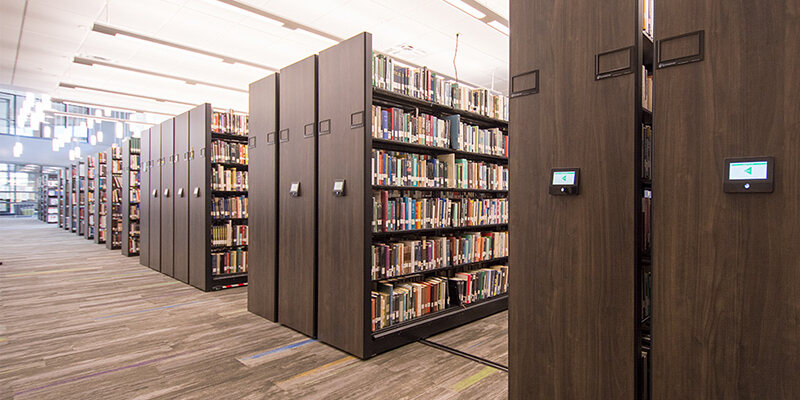
What exactly are rolling library shelves?
Rolling library shelves are a reimagining of stationary storage systems. Instead of static shelving, media cabinets or other storage, High-Density Mobile Storage Systems create movable aisles. This allows you to eliminate unnecessary aisles and creates more available space for more productive purposes, such as providing room for the “physicality of design thinking.”
This compact storage or movable storage solution lets you store twice as much in the same space by making use of vertical space and maximizing storage capacity with rolling library shelves. Users can still access the resources, whether the system is:
- Electrical-powered to give a touch of button access while helping boost efficiency and organization
- Mechanical-assist which uses a handle turn to easily move 4,000-10,000 pounds carriages with just one pound of effort
- Manual for a simple, cost-effective rolling library shelves solution
Each of these types of rolling shelves lets libraries make the most of limited space and reclaim their footprint for other uses, while fitting the aesthetics of your environment. Let’s consider some cases in point.
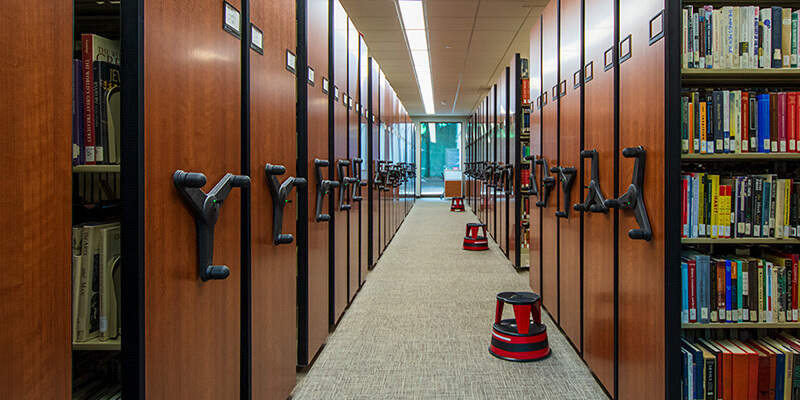
Books of course, but that’s not all
Library collections include so much more than their many volumes of books. Those are there too, of course, but rolling library shelves can also be configured to store flat files for architectural drawings, photographs, maps, or paintings. Or the extra large and heavy deed books. Or boxes of artifacts. Even masks, furniture, and skeletons. A lockable mobile shelving system can help libraries to secure their rare books or other valuable, historical artifacts.
At the College of Charleston, re-imagining library storage opened up the Addlestone Library for more students and research. Not only was the college population increasing in numbers, but the Carolina Historical Society also moved its cherished collection to the library. Change was essential to address the new needs; rolling library shelving made it possible without new construction.
Consolidating two large vaults for rare books and manuscripts in one climate-controlled, lockable mobile shelving system maximized the capacity and opened up the space. “It’s been hugely successful on both fronts,” said Claire Fund, the library’s Director of Administrative Services. With room for 200 additional seats for students, the library could also facilitate group work and creativity in design thinking.
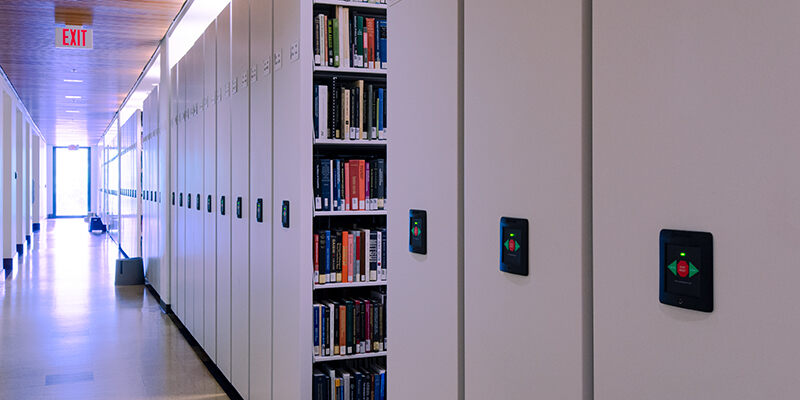
SPACE-SAVING for all sorts of libraries
Not all libraries have students or faculty needing to brainstorm and innovate. Yet any library can benefit from the space savings offered by a rolling library shelf installation.
The Atlanta Symphony Orchestra (ASO), for example, added three times the storage capacity to its music library. Although the actual space is relatively small at just over 1,100 square feet, it feels like much more with the addition of mechanical-assist shelving. “This room is where our music lives. We spend a lot of time here. We needed this,” said Principal Librarian Rebecca Beavers. “It’s been a wonderful transformation.”
Rolling library shelves were also transformative for Georgia State University. With little light getting in amidst the law library’s long aisles of books, the Atlanta campus space was functional rather than welcoming. By installing mobile storage, the library created additional capacity in less square footage. Repurposing old static shelving for use in the movable solution helped the budget too. Meanwhile, they opened up more and lighter, brighter spaces for students, faculty and community members.
“We now have these amazing views. What’s more, the high-density shelving allowed us to preserve the outer areas, near the windows, for study and collaborative space. The light and openness of the area create a much more inviting space,” said Kristina Niedringhaus, associate dean for library and information services. “The students love it. They congregate in different areas and can engage with one another in a different way than they could in the old library.”
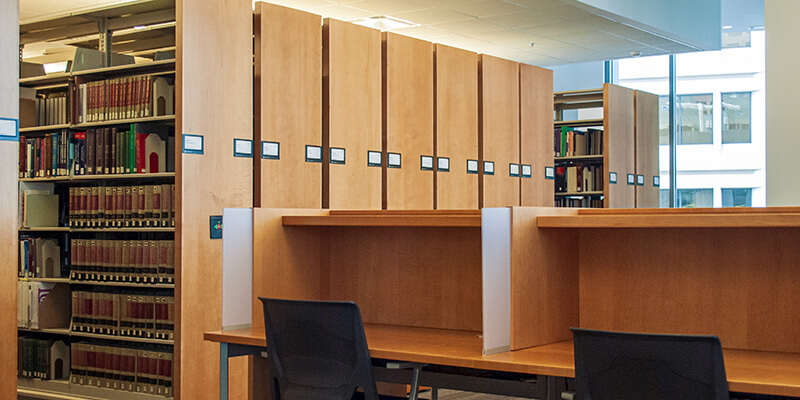
Do some thinking about your library design
Libraries need to be welcoming spaces if they are going to invite design thinking. Rolling library shelves maximize space, add capacity and can improve access, organization and security. But they can also be customized with finishes and materials that either align with your current design or make a statement.
At Embry-Riddle Aeronautical University, high-density rolling shelving expanded capacity in a functional way, said Melanie West, the library’s Associate Director for Access Services. “Through doing that, we were able to maximize the rest of the space for collaborative learning, student meetings and those more interactive services of a library.” At the same time, custom wood laminate end panels and tops add to the visual appeal of the library found in the university’s stunning student union building.
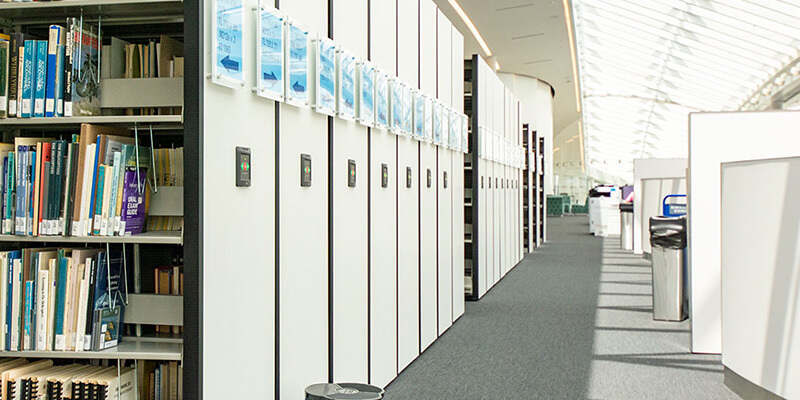
The options are limited only by your imagination, which is what design thinking is all about. Rolling library shelves are gaining popularity with forward-thinking libraries. Learn how our storage solutions can help make yours a library of the future. Contact us.












